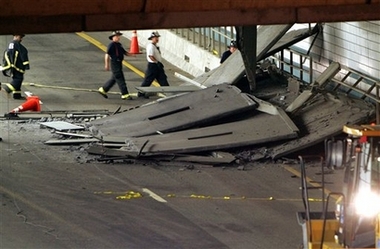'Epoxy creep' factor in Big Dig death
(AP)Updated: 2007-07-11 02:40
The fatal Big Dig tunnel collapse in Boston could have been avoided if authorities had considered that the epoxy securing tons of ceiling panels could slowly pull away, federal investigators concluded Tuesday.
 Fire fighters inspect a section of ceiling in the Interstate 90 connector tunnel eastbound through Boston that collapsed onto the roadway and killed a woman passenger in a car, in this July 11, 2006 file photo. On Tuesday, July 10, 2007, the first anniversary of the accident, the National Transportation Safety Board is expected to approve a final report on the probable cause of the collapse. The board is also expected to issue a series of recommendations. [AP]  |
The "epoxy creep" factor was among the major findings released at a hearing of the National Transportation Safety Board, which conducted a yearlong investigation into the collapse.
Milena Del Valle, 39, was crushed to death on July 10, 2006, when 12 tons of concrete ceiling panels fell from the roof of the Interstate 90 connector tunnel as she and her husband drove toward Logan Airport.
The panels had been fasted to the concrete tunnel roof with bolts anchored in epoxy. The investigation found that 20 anchors had pulled away from the tunnel roof.
The NTSB was meeting Tuesday to review and approve a final report on the probable cause of the ceiling collapse. The board was also expected to issue a series of recommendations.
Modern Continental Construction Co., the company that constructed the I-90 connector ceiling, used "fast-set" epoxy supplied by Powers Fasteners, Inc., to secure anchor bolts in the collapsed tunnel, investigators said.
"The design is reasonable, it's the epoxy that's the issue," said Bruce Magladry, director of the NTSB's Office of Highway Safety
Magladry described "epoxy creep" as the tendency of some epoxies to slowly give way under constant pressure. He said the epoxy used for the ceiling panels had "exceptionally poor" resistance to such creeping.
Magladry said there was no malice among those who built and oversaw the Big Dig.
"I don't think they understood creep at all," he said.
"Although the epoxy used in the tunnel had acceptable short term strength, it was incapable of supporting much lower loads over an extended period of time," Magladry said. "If any of the entities involved in the ceiling design and installation had considered creep as a possibility, a different epoxy or a different anchoring system would have been used."
The $14.798 billion Big Dig, the costliest highway project in U.S. history, was plagued by construction problems and multibillion-dollar cost overruns during its two decades of design and construction.
Last summer's accident led to tunnel shutdowns, extensive ceiling repairs, a wrongful death lawsuit and a wave of federal, state and criminal investigations, including the NTSB probe.
Del Valle's daughter, Raquel Ibarra Mora, said she was "extremely pleased" with the NTSB's thorough investigation.
"It's very difficult to relive this tragedy," Mora, 24, of Costa Rica, said through a translator.
Massachusetts Attorney General Martha Coakley is expected to announce soon whether she'll press criminal charges in connection with the accident.
Also pending is a wrongful death lawsuit filed by Del Valle's family against the Massachusetts Turnpike Authority, the agency overseeing the Big Dig, and several companies associated with design and construction of the project. The companies have said they stand behind their work.
Similar adhesive bolt anchors are used in tunnels in New York and Virginia, NTSB investigators said, but they hold lighter panels, weighing less than 500 pounds.
|
|
|
||
|
||
|
|